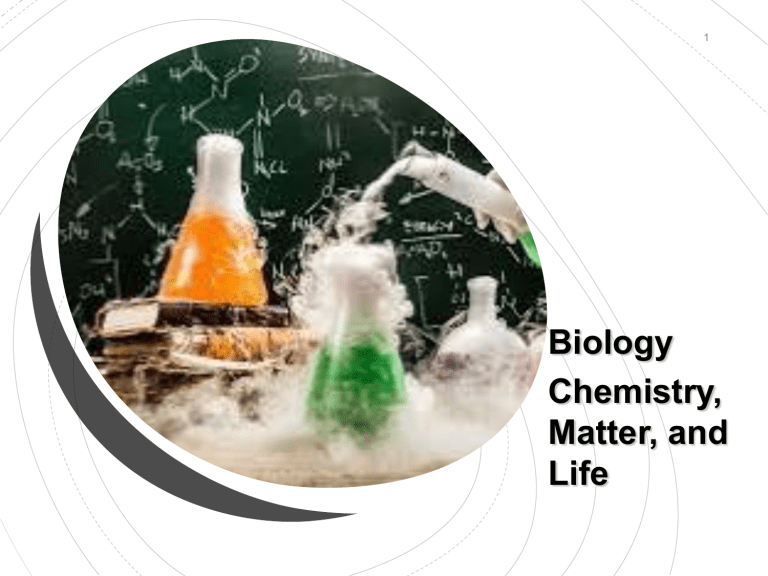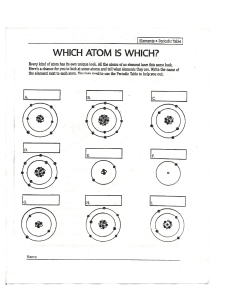
1 Biology Chemistry, Matter, and Life Chemistry Science that deals with composition and properties of matter Used to understand normal and abnormal functioning of body 2 Matter Anything that takes up space, has mass, and is composted predominantly of atoms consisting of protons, neutrons, and electrons, that constitutes the observable universe, and that is interconvertible with energy. 3 Elements • Substances from which all matter is made • Everything we see & touch are made of elements • There are 92 naturally occurring elements (20 additional created in Lab) • Periodic Table is a chart used to organize and describe the elements 4 Elements are Identified by Chemical Symbols Oxygen – O Nitrogen – N Potassium – K Chlorine – Cl Carbon – C Calcium – Ca Sulfur – Iron Hydrogen Phosphorus Sodium - S Fe H -P Na 5 What is the chemical symbol for potassium? a. Po b. Fe c. K 6 Subunits of elements are _________ Atoms are the smallest complete units of matter They cannot be broken down or changed into another form by ordinary chemical or physical means Atoms are so small.....millions can fit on a sharpened end of a pencil 7 Atomic Structure • Nucleus • Protons (positive charge [+]) • Neutrons (no charge) • Electrons (negative charge [–]) 8 Nucleus Center of the atom Contains particles - protons & neutrons Neutron Non-charged particle (neutral) 9 Proton (+) charged particle Electron (-) charged particle In orbit outside the nucleus Determines how the atom will react chemically 10 Protons (+) & Electrons (-) of an atom are always equal in number in its “normal” state, so that the atom has a neutral charge. A proton carries a positive charge (+) and an electron carries a negative charge (-), so the atoms of elements are neutral, all the positive charges canceling out all the negative charges. Atoms differ from one another in the number of protons, neutrons and electrons they contain. Positively charged protons [+] attract Negatively charged electrons [-] 11 12 Atomic Number No two elements share the same atomic number In the Periodic Table (Appendix 3 – Pg 435), the Atomic Number is located at the top of the box of each element Atomic Number Hydrogen – H = Carbon – C = Oxygen – O = Iron – Fe = 13 Atomic Weight Together, protons and neutrons contribute nearly all of the atomic weight 14 15 Energy Levels Molecules - Formed when two (2) or more atoms (elements) unite on the basis of their electron structure - Can be made of like atoms ex: O2 - More often made of two or more different atoms ex: H20 16 Compounds Substances composed of two or more different elements * Molecules are the smallest subunits of a compound Ex: carbon monoxide (CO) : 1 atom of carbon & 1 atom of oxygen water (H2O): atoms of hydrogen 2 1 atom of oxygen 17 Molecule or Compound ? O2 Oxygen H2O = = Water CO = Carbon Monoxide C6H12O6 = Glucose 18 The Importance of Water • Most abundant compound in body • Critical in all physiologic processes in body tissues • Deficiency (dehydration) can threaten health • Universal solvent • Stable liquid at ordinary temperatures • Participates in chemical reactions in body 19 Mixtures: Solutions & Suspensions - Not all elements or compounds combine chemically when brought together - Blends of two or more substances are… Mixtures 20 Mixtures 1. 2. 3. Combination or blends of different substances in which each substance remains intact and retains its separate properties Chocolate chip cookies (cookie dough & chocolate chips) Blood Plasma (platelets, RBC, WBC Air (nitrogen, oxygen, carbon dioxide & other substances) 21 Solution Mixture formed when one substance dissolves in another Ex: Salt Water, Koolaid, Coffee Types of Mixtures Suspension Mixture formed when the substance distributed in the background material is not dissolved and will settle out unless mixture is constantly shaken Ex: Oil & Vinegar or Italian Dressing, Finger Paints Colloid Particles do not dissolve but remain suspended Ex: Fruit in jello 22 Atoms interact chemically to alter the neutrality of atoms and form bonds. Chemical Bonds In chemical reactions, electrons may be transferred from one atom to another or may be shared between atoms. Two types of chemical bonds Ionic Bonds Covalent Bonds 23 Ionic Bonds ________________________________________ ________________________________________ If a sodium atom comes in contact with a chlorine atom, the chlorine atom gains an electron from the sodium atom and they form an Ionic bond. The newly formed ions (Na+ and Cl-), have opposite charges and are attracted to each other. They form the compound sodium chloride (table salt). 24 Electrolytes • • • • Ionically bonded substances Separate in solution into charged particles (ions) Cation [+] positive ion / Anion [-] negative ion Conduct electric current Influence homeostasis (stable condition of normal organism) (body fluids – proper function) Electrolytes are… salts – sodium chloride and potassium chloride acids & bases calcium, potassium, magnesium, sodium * Electrolytes must be present in exactly the right quantities in intracellular and extracellular fluids or damaging effects will result, preventing cells from functioning properly 25 Covalent Bonds Formed by _________ of electrons between atoms Non-polar covalent bond Polar covalent bond Equal sharing of electrons (ex: Hydrogen gas H2) Unequal sharing of electrons (ex: Water H20) 26 Nonpolar Covalent Bond 27 Acids, Bases and Salt Acids are molecules that dissociate in water, producing hydrogen ions (H+). Acids are ______________ ________ Chemical substance capable of donating a hydrogen ion (H+) to another substance 28 Acids, Bases and Salt Bases are molecules that are willing to _________ a hydrogen ion. A base is a chemical substance, usually containing a hydroxide ion (OH-), that can accept a hydrogen ion A base is also called an Alkali 29 3 0 Acids, Bases and Salt Salt is formed by a reaction between an acid and a base pH Scale (power of hydrogen) Used to measure relative acidity & alkalinity (base) of a solution Indicates the concentration of hydrogen ions (H+) in solution Acidic = greater concentration of H+ in a solution Basic (Alkaline) = greater concentration of OH- (hydroxide ion) in a solution As the concentration of H+ ↑, As the concentration of OH- ↑, the concentration of OH- ↓ the concentration of H+ ↓ 31 pH Scale Units are from 0 – 14 Each whole number on the pH scale, (014), represents a tenfold difference in hydrogen ion concentration 0 = most acidic 14 = most basic A pH of ___ is neutral Body fluids usually 7.357.45 pH 32 pH Scale 33 34 The only substance that has an absolute pH of 7 is… water 35 Buffers • Chemicals that prevent sharp changes in hydrogen ion concentration • Maintain relatively constant pH in body fluids 36 Isotopes and Radioactivity Elements can exist in several forms (isotopes) • Same number of protons and electrons • Different number of neutrons • Different atomic weights • May be stable or unstable (radioactive) 37 Use of Radioactive Isotopes Radioisotopes are the rays given off by some radioactive elements. Can penetrate and destroy cancer cells - Cancer therapy Can aid in diagnosis • X-rays • Tracers 38 Chemistry of Living Matter Of the 92 elements that exist in nature, only 26 have been found in living organisms 96% of cells are made up of 4 elements 1. Carbon 2. Hydrogen 3. Oxygen 4. Nitrogen (C) (H) (O) (N) 39 Chemistry of Living Matter 4% of cells are made up of 9 elements 1. Calcium (Ca) 2. Sodium (Na) 3. Potassium (K) 4. Phosphorus (P) 5. Sulfur (S) 6. Chlorine (Cl) 7. Magnesium(Mg) 8. Iron (Fe) 9. Iodine (I) The remaining 13 elements are found in “trace” amounts and include: Zinc, Selenium, Copper, Cobalt, Chromium, Boron, Fluorine, Aluminum, Silicon, Vanadium, Manganese, Molybdenum, Tin 40 Organic Compounds Chemical compounds that characterize living things • Contain carbon, hydrogen, and oxygen (carbon most identifying characteristic) Main Types of Organic Compounds – Carbohydrates – Lipids – Proteins 41 Organic Compounds Carbohydrates: Simple Sugars (monosaccharides) Lipids: Fats Proteins: Amino Acids (building blocks) Contain C, H, O and N (nitrogen) 42 Carbohydrates • Sugars and Starches • Made up of simple sugars Monosaccharides (simple sugars) – Glucose Disaccharides Polysaccharides – Starch – Glycogen 43 Lipids Fats and Steroids Fats made of glycerol and fatty acids • Triglycerides • Glycerol (glycerin) • Phospholipids • Steroids • Cholesterol • Steroid hormones • Sex hormones 4 4 4 5 Proteins • • Structural materials and Enzymes Made of amino acids (building blocks) Enzymes • Proteins essential for metabolic function. • Compound that speeds up the rate of a chemical reaction but is not changed in the reaction • Substance on which an enzyme works



